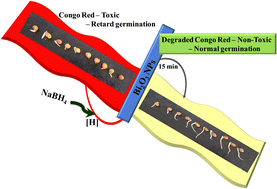Micelle assisted synthesis of bismuth oxide nanoparticles for improved chemocatalytic degradation of toxic Congo red into non-toxic products†
Abstract
Water released by industries that generate coloured pollutants must be treated to safeguard the environment and ensure that the treated water is non-toxic. In this study, we demonstrate the utility of glycine-derived designer micelles, N-lauroyl-N-(pyridin-2-ylmethyl)glycine (PyN12G), as a capping agent to prepare black bismuth oxide nanoparticles (Bi2O3 NPs). The obtained Bi2O3 NPs were confirmed by X-ray photoelectron spectroscopy and energy-dispersive X-ray spectroscopy. Transmission electron microscopy demonstrated that the Bi2O3 NPs are crystalline, with a quasi-spherical morphology and an average size of 42.3 nm, which are further corroborated by powder X-ray diffraction studies to be monoclinic. Fourier transform infrared spectra revealed that the surface of Bi2O3 NPs was stabilized by PyN12G and that the –COOH group of the micelles was involved in surface functionalization. The application of Bi2O3 NPs in environmental remediation was demonstrated by degrading a toxic dye, Congo red (CR). Bi2O3 NPs catalyze sodium borohydride-mediated CR degradation with an efficiency of 88.8% in 15 minutes and a rate constant of 1.92 × 10−3 s−1. Besides CR, Bi2O3 NPs catalyzed the degradation of methylene blue, bromophenol blue, Coomassie blue, crystal violet, and rhodamine B with efficiencies of 95%, 92%, 95%, 90%, and 86%, respectively. Gas chromatography-mass spectrometry analysis reveals that CR is degraded into smaller molecules. The disclosed dye degradation process eliminates the hazardous feature of the dye, which was proven by the seed germination assay. Furthermore, toxicology experiments revealed that Bi2O3 NPs do not affect bacterial growth or seed germination, proving that the NPs are non-toxic and safe to use as a chemocatalyst to eliminate toxic dyes without affecting the environment.



 Please wait while we load your content...
Please wait while we load your content...